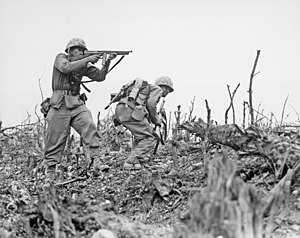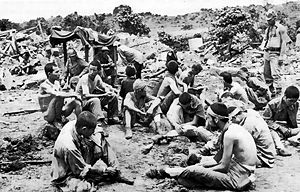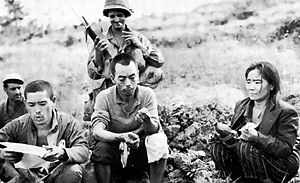|
Battle of Okinawa
From Wikipedia, the free encyclopedia
| Battle of Okinawa |
| Part of World War II, the Pacific War |

A Marine of the 1st Marine Division draws a bead on a Japanese sniper with his Thompson as his companion ducks for cover |
|
|
| Combatants |
 United States, United States,
 United Kingdom, United Kingdom,
 Canada, Canada,
 New Zealand, New Zealand,
 Australia Australia |
 Empire of Japan Empire of Japan |
| Commanders |
 Simon B. Buckner†, Simon B. Buckner†,
 Joseph W. Stilwell, Joseph W. Stilwell,
 Ray Spruance Ray Spruance
|
 Mitsuru Ushijima† Mitsuru Ushijima†
 Isamu Cho† Isamu Cho† |
| Strength |
548,000 regulars,
1300 ships,
? aircraft |
100,000 regulars and militia,
? ships,
? aircraft |
| Casualties |
12,513 dead or missing,
38,916 wounded,
33,096 non-combat wounded,
79
ships sunk and scrapped,
763 aircraft destroyed |
66,000 dead or missing,
17,000 wounded,
7,455 captured,
16 ships sunk
and scrapped,
7,830 aircraft destroyed,
140,000 civilians dead or missing |
The Battle of Okinawa, fought on the Japanese island of Okinawa, was the largest amphibious assault during the Pacific campaigns of World War II. It lasted from late March through June 1945.
The battle has been referred to as the "Typhoon of Steel" in English, and tetsu no ame ("rain of steel") or tetsu
no bōfū ("violent wind of steel") in Japanese. The nicknames refer to the ferocity of the fighting, the intensity
of gunfire involved, and sheer numbers of Allied ships and armoured vehicles that assaulted the island. Okinawa had a large civilian population, of whom at least 150,000
were killed during the battle, while the Japanese army attempted to defend the island they had invaded centuries earlier.
Neither side expected Okinawa to be the last major battle of the war, which it in fact was. The Allies were planning Operation Downfall, the invasion of Kyūshū and Honshū, which never happened due to the Japanese surrender, after the atomic bombings of Hiroshima and Nagasaki in August 1945 and the Soviet Union’s declaration of war on Japan.
The forces
Land
The U.S. land campaign was controlled by the Tenth Army, commanded by Lieutenant General Simon Bolivar Buckner, Jr. The army had two corps under its command, III Amphibious Corps, consisting of 1st and 6th Marine Divisions, with 2nd Marine Division as an afloat reserve, and XXIV Corps, consisting of the 7th, 27th, 77th and 96th Infantry Divisions.
The Japanese land campaign (mainly defensive) was conducted by the 100,000 strong 32nd Army. It initially consisted of the 9th, 24th, and 62nd Divisions, and the 44th Independent Brigade. The 9th Division was moved
to Formosa prior to the invasion, resulting in shuffling of Japanese Defensive plans. Primary resistance was to be led in the south
by General Mitsuru Ushijima, his second in command Gen. Isamu Cho and chief of staff Major Hiromichi Yahara. Yahara advocated a defensive strategy, whilst Cho advocated an offensive one. In the north, General Takehido Udo was in command.
Realizing that he could never defend the entire island, Ushijima centered his defense around the historical capital, Shuri Castle, a medieval fortress of the ancient Ryukyuan kings, and the steep ridges on which it was built. This provided the Japanese
with a heavy defense line that could be flanked only from the sea. For the first time in the Pacific War, the Japanese not only had ample time to dig elaborate fortifications, much as they had on Iwo Jima, they also had large numbers of tanks and artillery pieces. This relative abundance of materiel, matched with thousands of troops and the knowledge of three years fighting the U.S., ensured that the Okinawa defenses would
be the hardest that the U.S. faced during the war. Ushijima knew the Allies could not be stopped, but he wanted to make them
pay for every yard of advance.
Sea
U.S. Navy
British Commonwealth
Although the land battle was an entirely U.S. operation, the British Pacific Fleet (BPF; known to the U.S. Navy as Task Force 57) provided about 20% of Allied naval air power. The fleet was a combined British Commonwealth carrier group with British, Canadian, New Zealand and Australian ships and personnel. Their mission was to neutralize Japanese airfields at Sakishima Gunto.
Naval battle
BPF was assigned the task of neutralising the Japanese airfields, which worked very well indeed, in the Sakishima Islands, which it did from 26 March until 10 April. On 10 April, its attention was shifted to airfields on northern Formosa. The force withdrew to San Pedro Bay on 23 April. Although by then a commonplace event for the U.S. Navy, this was the longest time that a Royal Naval fleet of that size
had been maintained at sea.
From 4 May 1945, BPF returned to action, subduing the airfields as before, this time with naval bombardment as well as aircraft. A number
of kamikaze attacks caused significant damage but only a brief interruption to the force's work. They finally withdrew to
Guam and Manus Island on 25 May.
Perhaps the most dramatic action of this campaign occurred far from Okinawa itself: the attempted kamikaze attack by a
strike force of Japanese surface vessels led by the battleship Yamato. The Yamato and other vessels in Operation Ten-Go were intercepted shortly after leaving Japanese home waters. Under attack from more than 300 carrier aircraft, the world's
largest battleship sank on 7 April 1945, long before she could reach Okinawa, where the ship would have created havoc for
Allied forces. A series of attacks over a two day span were successful in sinking the Yamoto. Torpedo bombers were
instructed to only aim for one side of the ship so the water flooding would not help the Yamoto stay even keeled. Also,
the torpedo bombers were told to aim for the bow and stern where the armor was weaker. Part of the Yamoto's screening
force also suffered damage. After the sinking, the Japenese Navy ceased operations and was not a participant in the remainder
of the war.
Land battle

A U.S. F4U Corsair fires rockets on a run against a Japanese positions
The land battle took place over about 82 days from April 1, 1945.
The north
The U.S. swept across the thin part of the south-central part of the island, with relative ease by World War II standards,
soon taking the lightly-held north, though there was fierce fighting at Mount Yae-dake, and took the Kadena and the Yomitan airbases.
Few U.S. soldiers encountered the feared Habu snake, and soon discarded the cumbersome leggings designed to protect them from snakebite.
The entire north fell on April 20.
Cho's offensive strategy led to a disastrous land and sea attack that caused the near massacre of the attacking Japanese
troops by the superior firepower of the U.S. soldiers. From then on, Ushijima adopted the more successful tactics advocated
by Major Yahara.
Fighting in the south was hardest: the Japanese soldiers hid in caves armed with hidden machine guns and explosives; U.S.
forces often lost many men before clearing the Japanese out from each cave or other hiding place. The Japanese would send
the Okinawans at gunpoint out to acquire water and supplies for them, which induced casualties among civilians. The U.S. advance
was inexorable but resulted in massive casualties sustained by both sides.
On May 29, Brig. Gen. Pedro del Valle, commanding the 1st Marine Division, ordered Company A, 1st Battalion, 5th Marines to capture Shuri Castle. Seizure of the castle represented both strategic and psychological blows for the Japanese and was
a milestone in the campaign.
The island fell on about June 21, 1945, though some Japanese continued fighting, including the future governor of Okinawa prefecture, Masahide Ota.
Ushijima and Cho committed suicide by seppuku in their command headquarters on Hill 89 in the closing hours of the battle. Major Yahara had asked Ushijima for permission
to commit suicide, but the general refused his request, saying, "If you die there will be no one left who knows the truth
about the battle of Okinawa. Bear the temporary shame but endure it. This is an order from your army Commander." Yahara was
the most senior officer to have survived the battle on the island, and later authored a book entitled The Battle for Okinawa.
Aftermath
At some battles, such as Iwo Jima, there had been no civilians involved, but Okinawa had a large indigenous civilian population. Okinawan civilian losses in
the campaign were in excess of 140,000; in addition, it is estimated that more than a third of the surviving civilian population
were wounded. U.S. losses were over 72,000 casualties, of whom 12,513 were killed or missing, over twice the number killed
at Iwo Jima and Guadalcanal combined. Several thousand soldiers who died indirectly (from wounds and other causes), at a later date, are not included
in the total. About a third of the civilian population of the island were killed in the spring of 1945.

A group of Japanese prisoners who preferred capture to suicide
There were about 66,000 Japanese combatants killed and 7,000 captured. Some of the soldiers committed seppuku or simply blew themselves up with grenades. Some of the civilians, having been induced by Japanese propaganda to believe that U.S. soldiers were barbarians who committed horrible atrocities, killed their families and themselves to
avoid capture. It is believed many Okinawans threw themselves and their family members from the cliffs where the Peace Museum
now resides. Other Okinawans were murdered by Japanese to prevent their capture or to steal their food and supplies. Ironically,
this was also the first (and only) battle in the war in which the Japanese surrendered by the thousands. (Also as this was
an intense battle, many civilians were killed by both the Japanese and American Army. Whether or not this was intentional
is debatable).
When the American forces occupied the island, the Japanese took Okinawan clothing to avoid capture. The Okinawans came
to the Americans' aid by offering a simple way to detect Japanese in hiding. Okinawan dialect differs greatly from standard
Japanese. With Americans at their sides, Okinawans would give directions to people in the local dialect, and those who didn't
understand were obviously Japanese in hiding who were then captured.

The last picture of Lieutenant General Buckner
At the very end of the campaign, Buckner was killed by a Japanese ricocheting artillery shell while inspecting his troops
at the front line, just 4 days before the end of the battle. He was the second highest-ranking U.S. officer to die during
the war. His death, so near the end of the battle and the war, was ironic, for it was Buckner's decision to attack the Japanese
defenses head-on, which proved to be extremely costly in U.S. lives, although the attack was ultimately successful. It was
also his failure to detect the Japanese retreat to their second line of defense that led to the greatest slaughter on Okinawa
in the latter stages of the battle, including the deaths of uncounted thousands of civilians.
U.S. forces suffered their highest ever casualty rate for combat stress reaction during the entire battle, at 48% (compared to 30% in the Korean War).
The most famous U.S. casualty was the war correspondent Ernie Pyle, who was killed by Japanese sniper fire on Ie Shima, just off the northwest coast of Okinawa.
Del Valle was awarded a Distinguished Service Medal for his leadership in the fight to take Okinawa and the subsequent occupation and reorganization of Okinawa.
Some military historians believe that Okinawa led directly to U.S. use of the atomic bomb, on Hiroshima and Nagasaki. A prominent holder of this view is Victor Davis Hanson, who states it explicitly in his book Ripples of Battle:
- ...because the Japanese on Okinawa, including native Okinawans, were so fierce in their defense (even when cut off,
and without supplies), and because casualties were so appalling, many American strategists looked for an alternative means
to subdue mainland Japan, other than a direct invasion. This means presented itself, with the advent of atomic bombs, which
worked admirably in convincing the Japanese to sue for peace, without American casualties. Ironically, the American conventional
fire-bombing of major Japanese cities (which had been going on for months before Okinawa) was far more effective at killing
civilians than the atomic bombs and, had the American simply continued, or expanded this, the Japanese would likely have surrendered
anyway. Nevertheless, the bombs were a powerful symbolic display of American power, and the Japanese capitulated, obviating
the need for an invasion of the home islands.
In 1945, Winston Churchill called the battle "among the most intense and famous in military history."
After the battle, the U.S. occupied Okinawa, and set up the Government of the Ryukyu Islands. Significant U.S. forces remain garrisoned there and Kadena remains the largest U.S. air base in Asia.
Civilian casualties

Overcoming the civilian resistance on Okinawa was aided by propaganda leaflets, one of which is being read by a prisoner
awaiting transportation to the rear
During World War II, when many Okinawans still spoke a different dialect, Japanese troops treated the locals brutally.
In its history of the war, the Okinawa Prefectural Peace Memorial Museum presents Okinawa as being caught in the fighting
between America and Japan — a starkly different view from the Yasukuni Shrine war museum, which presents Japan as a
liberator of Asia from Western powers.
During the 1945 battle, during which one quarter of the civilian population was killed, the Japanese Army showed indifference
to Okinawa’s defense and safety. Japanese soldiers used civilians as shields against the Americans, and persuaded locals
that victorious American soldiers would go on a rampage of killing and raping. With the impending victory of American troops,
civilians committed mass suicide, urged on by fanatical Japanese soldiers.
“There are many Okinawans who have testified that the Japanese Army directed them to commit suicide,” Ryukyu
Shimpo, one of the two major Okinawan newspapers, said in an angry editorial. “There are also people who have testified
that they were handed grenades by Japanese soldiers” to blow themselves up.
Quotes
- "7,613 were killed and missing in action (this figure does not include U.S Navy killed), and the remaining sixty-four-odd
thousand were almost equally divided between those wounded seriously enough to be out of action more than a week and non-battle
casualties, chiefly victims of battle fatigue."
- "Ninety percent of the buildings on the island were completely destroyed, and the lush tropical landscape was turned into
a vast field of mud, lead, decay and maggots."
- "By the end of May monsoon rains which turned contested slopes and roads into a morass exacerbated both the tactical and
medical situations. The ground advance began to resemble a World War I battlefield as troops became mired in mud and flooded
roads greatly inhibited evacuation of wounded to the rear. Troops lived on a field sodden by rain, part garbage dump and part
graveyard. Unburied Japanese bodies decayed, sank in the mud, and became part of a noxious stew. Anyone sliding down the greasy
slopes could easily find their pockets full of maggots at the end of the journey."
- "While on Okinawa, the marines and soldiers were going through their crucible of hell brought on by rain, heat, poison
snakes, mosquitoes...the stench of human feces and rotting human flesh filled with maggots...."
- "There was a hypnotic fascination to the sight so alien to our Western philosophy. We watched each plunging kamikaze with
the detached horror of one witnessing a terrible spectacle rather than as the intended victim. We forgot self for the moment
as we groped hopelessly for the thought of that other man up there."
|

